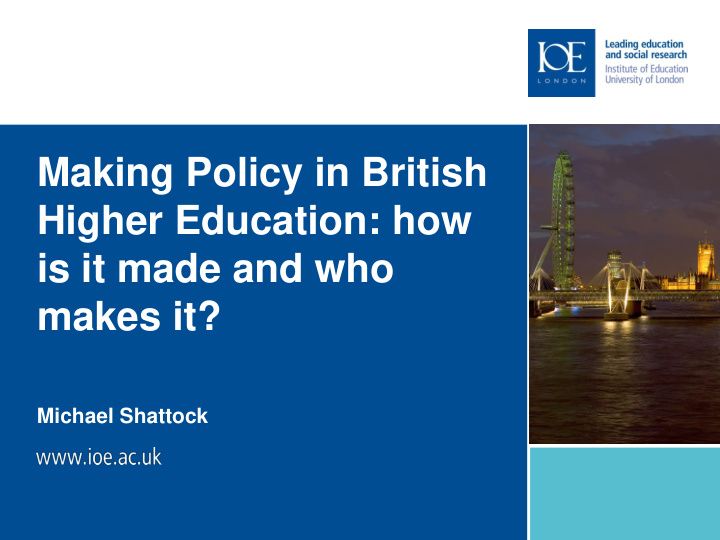



Making Policy in British Higher Education: how is it made and who makes it? Michael Shattock
Introduction • Is there a model structure? How its done elsewhere: Germany, France, the USA, Australia • The relevance of policy process theory — disjointed incrementalism, the development of policy as a complex bargaining process • The unusual David Willetts: discontinuity or continuity
What constitutes the distinctiveness of British higher education policy making? • The a-political character of most HE policy making; the peripheral nature of HE within educational policy making and within government • The interplay of policy networks; policy change driven by Treasury (PES); the Department(s); Cabinet Office; intermediary bodies (Funding Councils, Research Councils); representative bodies (UUK, Russell Group, NUS); think tanks (HEPI, IPPR, Policy Exchange); very rarely, Parliament; even more rarely, HEIs • Policy ambiguities — institutional autonomy v policy centralisation; devolution; research v teaching; the public interest v the student interest
Rationality and the policy process “My experience of government was shocking for me. I had expected that the nearer one got to the commanding heights, the more rational it would all be. The more calmness, the more rationality, the more careful consideration, looking at evidence. I discovered the opposite. Ministers were in a constant state of mild panic rushing from one thing to the next, never having time to grasp any issue, needing to make a decision in extraordinary short periods of time and often trying to make decisions without grasping the issues. The officials tried to rush around to clear up the mess” ( Kogan interview 1995) “ most of the significant developments of the decade [1980s] happened in a piecemeal fashion. There were certainly overall trends in policy, though these could by no means be assembled into any kind of grand strategy. Indeed in my judgement, the creation of an embracing strategy was always beyond reach….” (Bird 1994)
The role of the Treasury • 1961 the Plowden Report The Control of Public Expenditure Cmnd 1432: the creation of PESC • The Cabinet decision on public expenditure • Comprehensive Spending Reviews • The allocation process — the Dept, PES, the Star Chamber • The Browne Report and the 2010 CSR
What are the underlying policy drivers? • Student numbers — political pressure, economic considerations (since 1946) • Research — the Innovation agenda (since early 1980s) • Global league tables — (since 2002) • The public expenditure implications of the above • Reactive not proactive policy making
How key policy decisions were made • 1980 - overseas students’ fees • 1986 - decision to expand student numbers • 1992 - ending the binary line • 2003 - introduction of top up fees
The 2010 CSR and after: discontinuity or continuity? • The Browne Report and the financial crisis • The 2011 White Paper: autonomy v centralised policy; HEFCE’s new role in a regulated market • 2014 and the removal of the cap; selling the loan book • 2014 The PAC, the RAB and the loan book • The policy implications???
Reference Shattock M L (2012) Making Policy in British Higher Education 1945-2011 , Maidenhead: McGraw-Hill/ Open University Press .
Recommend
More recommend